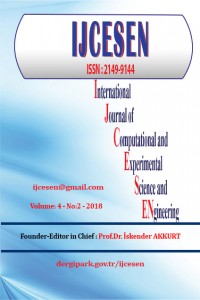Öz
Various projects are realized
by private sector and public institutions in recent days. Machine, material,
manpower, time and money are the main resources required for these projects.
Since, each one is a cost item, these sources should be used effectively in
order to provide competitive advantage in the project planning process. In this
context, an efficient project management system provides effective usage of resources,
good working environment and timely completion of projects. Critical Path
Method (CPM) and Program Evaluation and Review Technique (PERT) are utilized as
project planning methods in order to determine the completion time of projects.
On the other hand, it can be possible to complete a project earlier using
additional sources with project crashing approach. In this study, initially activities
and durations for a construction project realized in Kocaeli have been
determined. Afterwards, expected completion time, critical activities and
critical path have been determined for this project. In the second phase,
project crashing cost for critical activities has been calculated through a
mathematical model. Thus, the applicability of the project management model has
been revealed.
Anahtar Kelimeler
Project Management PERT Project Crashing Construction Sector
Kaynakça
- [1] W. Winston, Operations Research Applications and Algorithms, 4th ed., 2003.
- [2] N. Ibadov, Determination of the Risk Factors Impact on the Construction Projects Implementation Using Fuzzy Sets Theory, Acta Physica Polonica A 130(2016) 107-111. 10.12693/APhysPolA.130.107
- [3] L.O. Ugur, A Neuro-Adaptive Learning (NAL) Approach about Costs of Residential Buildings, Acta Physica Polonica A 132(2017) 585-587. 10.12693/APhysPolA.132.585
- [4] A. Recioui, Design and Thinning of Linear and Planar Antenna Arrays Using a Binary Teaching Learning Optimizer, Acta Physica Polonica A 130(2016) 7-8. 10.12693/APhysPolA.130.7
- [5] S. Foldes, F. Soumis, PERT and crashing revisited: Mathematical generalizations, European Journal of Operational Research 64(1993) 286-294. https://doi.org/10.1016/0377-2217(93)90183-N
- [6] M.F. Shipley, A. Korvin, K. Omer, BIFPET methodology versus PERT in project management: fuzzy probability instead of the beta distribution, Journal of Engineering and Technology Management 14(1997) 49-65. https://doi.org/10.1016/S0923-4748(97)00001-5
- [7] S. Gümüsoglu, H. Tütek, An analysis method in project management using primal-dual relationships, International Journal of Project Management 16(1998) 321-327. https://doi.org/10.1016/S0263-7863(97)00057-4
- [8] G.Y. Abbasi, A.M. Mukattash, Crashing PERT networks using mathematical programming, International Journal of Project Management 19(2001) 181-188. https://doi.org/10.1016/S0263-7863(99)00061-7
- [9] T. Yang, Performing complex project crashing analysis with aid of particle swarm optimization algorithm, International Journal of Project Management 25(2007) 637-646.
- [10] D. Trietsch, K.R. Baker, PERT21: Fitting PERT/CPM for use in the 21st century, International Journal of Project Management 30(2012) 490-502. https://doi.org/10.1016/j.ijproman.2011.09.004
- [11] F. Cebi, I. Otay, A fuzzy multi-objective model for solving project network problem with bonus and incremental penalty cost, Computers & Industrial Engineering 82(2015) 143-150.
- [12] B.H. Tabrizi, S.F. Ghaderi, A robust bi-objective model for concurrent planning of project scheduling and material procurement, Computers & Industrial Engineering 98(2016) 11-29.
- [13] A.H.I. Lee, HY. Kang, TT. Huang, Project management model for constructing a renewable energy plant, Procedia Engineering 174(2017) 145-154. https://doi.org/10.1016/j.proeng.2017.01.186
- [14] B.G. Soto, A. Rosarius, J. Rieger, Q. Chen, B.T. Adey, Using a Tabu-search Algorithm and 4D Models to Improve Construction Project Schedules, Procedia Engineering 196(2017) 698-705.
Öz
Kaynakça
- [1] W. Winston, Operations Research Applications and Algorithms, 4th ed., 2003.
- [2] N. Ibadov, Determination of the Risk Factors Impact on the Construction Projects Implementation Using Fuzzy Sets Theory, Acta Physica Polonica A 130(2016) 107-111. 10.12693/APhysPolA.130.107
- [3] L.O. Ugur, A Neuro-Adaptive Learning (NAL) Approach about Costs of Residential Buildings, Acta Physica Polonica A 132(2017) 585-587. 10.12693/APhysPolA.132.585
- [4] A. Recioui, Design and Thinning of Linear and Planar Antenna Arrays Using a Binary Teaching Learning Optimizer, Acta Physica Polonica A 130(2016) 7-8. 10.12693/APhysPolA.130.7
- [5] S. Foldes, F. Soumis, PERT and crashing revisited: Mathematical generalizations, European Journal of Operational Research 64(1993) 286-294. https://doi.org/10.1016/0377-2217(93)90183-N
- [6] M.F. Shipley, A. Korvin, K. Omer, BIFPET methodology versus PERT in project management: fuzzy probability instead of the beta distribution, Journal of Engineering and Technology Management 14(1997) 49-65. https://doi.org/10.1016/S0923-4748(97)00001-5
- [7] S. Gümüsoglu, H. Tütek, An analysis method in project management using primal-dual relationships, International Journal of Project Management 16(1998) 321-327. https://doi.org/10.1016/S0263-7863(97)00057-4
- [8] G.Y. Abbasi, A.M. Mukattash, Crashing PERT networks using mathematical programming, International Journal of Project Management 19(2001) 181-188. https://doi.org/10.1016/S0263-7863(99)00061-7
- [9] T. Yang, Performing complex project crashing analysis with aid of particle swarm optimization algorithm, International Journal of Project Management 25(2007) 637-646.
- [10] D. Trietsch, K.R. Baker, PERT21: Fitting PERT/CPM for use in the 21st century, International Journal of Project Management 30(2012) 490-502. https://doi.org/10.1016/j.ijproman.2011.09.004
- [11] F. Cebi, I. Otay, A fuzzy multi-objective model for solving project network problem with bonus and incremental penalty cost, Computers & Industrial Engineering 82(2015) 143-150.
- [12] B.H. Tabrizi, S.F. Ghaderi, A robust bi-objective model for concurrent planning of project scheduling and material procurement, Computers & Industrial Engineering 98(2016) 11-29.
- [13] A.H.I. Lee, HY. Kang, TT. Huang, Project management model for constructing a renewable energy plant, Procedia Engineering 174(2017) 145-154. https://doi.org/10.1016/j.proeng.2017.01.186
- [14] B.G. Soto, A. Rosarius, J. Rieger, Q. Chen, B.T. Adey, Using a Tabu-search Algorithm and 4D Models to Improve Construction Project Schedules, Procedia Engineering 196(2017) 698-705.
Ayrıntılar
| Birincil Dil | İngilizce |
|---|---|
| Bölüm | Makaleler |
| Yazarlar | |
| Yayımlanma Tarihi | 2 Temmuz 2018 |
| Gönderilme Tarihi | 17 Nisan 2018 |
| Kabul Tarihi | 14 Mayıs 2018 |
| Yayımlandığı Sayı | Yıl 2018 Cilt: 4 Sayı: 2 |


